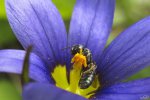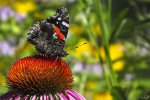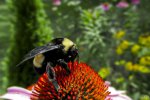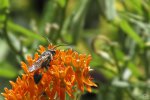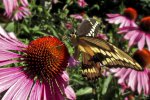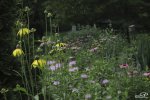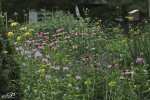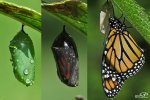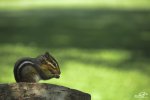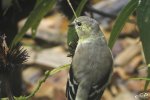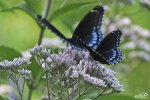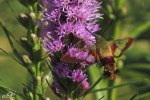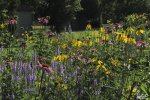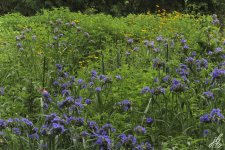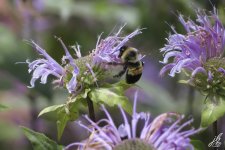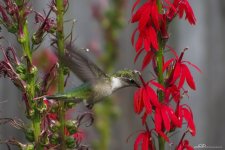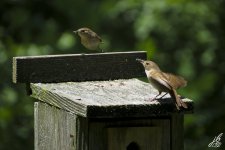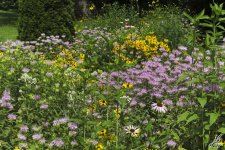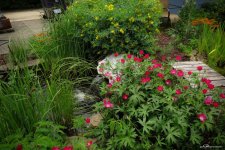Your Garden
Welcome to my native garden!



I began creating my native garden in 2014 after realizing that wildlife needs our help. It initially began as just a 64 square foot garden, but after adding on every year since, I now have over 3,000 square feet of native garden space! Below, I've included a blueprint that I created of my main native garden. As you can see, I have an eastern half and a western half that surrounds my fire pit and picnic table. I also have a small garden space around my shed, and a few other gardens in other parts of the yard not shown on this blueprint, including a garden pond. The "pumpkins and things" section has since been changed over to native garden as well.

My garden is a habitat restoration filled with plants that are native to North America. While a true prairie can have up to 80% grasses, I currently only have a few clumps of Side Oats Grama and Little Bluestem, and am working to seed more each year. I currently have around 40 species of forbs in my garden, with most of them being native to Wisconsin. In this photo, you can see plenty of spiderwort, which was one of the first native plants I added to my garden. This specie originally came from my late grandma's garden when she allowed me to divide some for myself. Now it's made a home across my native garden and puts on an incredible show every June.

This project is all about helping wildlife. Tallgrass prairie habitat is nearly extinct. Thanks to humans, less than 3% of original tallgrass prairie remains, and it's almost entirely in small fragments that are degrading with each passing year. While my garden does not make up for that lost habitat, it does provide wildlife a miniature sanctuary where they can find food, shelter, nesting material, and nesting cavities in stems and soil. If enough people create native gardens in their backyard, it will create a chain of habitats that can help wildlife move from one larger habitat to another without struggling to find food. I've seen life increase in my native garden every year, and it's been extremely rewarding. Here are a few species that have made use of my garden.
The Rusty-patched bumble bee. This bee made national headlines in 2017 when it became the first bumble bee to be placed on the endangered specie list. Its population has declined by 87% in the last 20 years. Luckily, I am in its native range and I have a population in my area that shows up to my garden each year!

Giant Swallowtail. The largest butterfly in the United States. Not common in Wisconsin, but I see one or two in my garden each year.

Monarch Butterfly, which has been proposed to be an endangered specie, is in my garden each year. Although even I have seen a sharp decrease over the past 6-7 years. I don't see them nearly as often anymore.

While I wanted a very colorful garden, I also had the goal of attracting specific wildlife. I wanted to help Monarchs, so I planted multiple milkweed species as well as some of their favorite nectar sources. I wanted to help Fritillary butterflies, so I planted Common Blue Violet. I wanted to help Ruby-throated Hummingbirds, so I planted a few of their favorite plants, including Cardinal flower.

There have been other ways that I've made my garden even more beneficial to wildlife.
- I don't cut my plants down to the ground after they die off for the year. The seed heads provide food for birds in autumn and winter. After that, I cut the stems down to about one to two feet tall. Those stems will then become shelters for insects, and small, harmless bees will lay eggs in them. The stems will be hidden before summer by new growth, and will continue to benefit insects for the remainder of the year.

- I place a few logs randomly throughout the garden. They provide shelter for wildlife such as American Toads. Quite often, I'll lift a log to see what's under it and I'll find a Toad or two. I also have a wood pile next to the garden. Wood piles and brush piles are fantastic places for wildlife. I often find chipmunks running around the pile and searching for food.

- I've added nesting boxes for birds in my garden. Originally, I designed the boxes for tree swallows, but non-native house sparrows kept taking over all the boxes. In 2024, I changed the hole size on all the houses to allow for only small birds like house wrens and chickadees. Almost immediately, house wrens moved in to three of my boxes!

I also have an 800 gallon pond that I also installed in 2014. The original goal was simply to attract frogs to my yard, but it also ultimately became so much more. Damselflies are often seen flying around the pond and laying their eggs in the pond. Birds come to bathe and drink. Chipmunks and squirrels always stop by the bog filter to grab a drink. I've planted many native wetland plants in my bog filter and pond, and other native species around the outer edges.


Here's a complete list (as of March 25, 2025) of all 78 plant species in my yard. I've also included bloom color as well as icons that show which species are native to my county, within 100 miles of my county, and beyond.

Please consider adding your own colorful and beneficial native plant garden! It's extremely important to the future of our world that we all start restoring some habitat, even if it begins with something as simple as native gardening.








I began creating my native garden in 2014 after realizing that wildlife needs our help. It initially began as just a 64 square foot garden, but after adding on every year since, I now have over 3,000 square feet of native garden space! Below, I've included a blueprint that I created of my main native garden. As you can see, I have an eastern half and a western half that surrounds my fire pit and picnic table. I also have a small garden space around my shed, and a few other gardens in other parts of the yard not shown on this blueprint, including a garden pond. The "pumpkins and things" section has since been changed over to native garden as well.
My garden is a habitat restoration filled with plants that are native to North America. While a true prairie can have up to 80% grasses, I currently only have a few clumps of Side Oats Grama and Little Bluestem, and am working to seed more each year. I currently have around 40 species of forbs in my garden, with most of them being native to Wisconsin. In this photo, you can see plenty of spiderwort, which was one of the first native plants I added to my garden. This specie originally came from my late grandma's garden when she allowed me to divide some for myself. Now it's made a home across my native garden and puts on an incredible show every June.
This project is all about helping wildlife. Tallgrass prairie habitat is nearly extinct. Thanks to humans, less than 3% of original tallgrass prairie remains, and it's almost entirely in small fragments that are degrading with each passing year. While my garden does not make up for that lost habitat, it does provide wildlife a miniature sanctuary where they can find food, shelter, nesting material, and nesting cavities in stems and soil. If enough people create native gardens in their backyard, it will create a chain of habitats that can help wildlife move from one larger habitat to another without struggling to find food. I've seen life increase in my native garden every year, and it's been extremely rewarding. Here are a few species that have made use of my garden.
The Rusty-patched bumble bee. This bee made national headlines in 2017 when it became the first bumble bee to be placed on the endangered specie list. Its population has declined by 87% in the last 20 years. Luckily, I am in its native range and I have a population in my area that shows up to my garden each year!
Giant Swallowtail. The largest butterfly in the United States. Not common in Wisconsin, but I see one or two in my garden each year.
Monarch Butterfly, which has been proposed to be an endangered specie, is in my garden each year. Although even I have seen a sharp decrease over the past 6-7 years. I don't see them nearly as often anymore.
While I wanted a very colorful garden, I also had the goal of attracting specific wildlife. I wanted to help Monarchs, so I planted multiple milkweed species as well as some of their favorite nectar sources. I wanted to help Fritillary butterflies, so I planted Common Blue Violet. I wanted to help Ruby-throated Hummingbirds, so I planted a few of their favorite plants, including Cardinal flower.
There have been other ways that I've made my garden even more beneficial to wildlife.
- I don't cut my plants down to the ground after they die off for the year. The seed heads provide food for birds in autumn and winter. After that, I cut the stems down to about one to two feet tall. Those stems will then become shelters for insects, and small, harmless bees will lay eggs in them. The stems will be hidden before summer by new growth, and will continue to benefit insects for the remainder of the year.
- I place a few logs randomly throughout the garden. They provide shelter for wildlife such as American Toads. Quite often, I'll lift a log to see what's under it and I'll find a Toad or two. I also have a wood pile next to the garden. Wood piles and brush piles are fantastic places for wildlife. I often find chipmunks running around the pile and searching for food.
- I've added nesting boxes for birds in my garden. Originally, I designed the boxes for tree swallows, but non-native house sparrows kept taking over all the boxes. In 2024, I changed the hole size on all the houses to allow for only small birds like house wrens and chickadees. Almost immediately, house wrens moved in to three of my boxes!
I also have an 800 gallon pond that I also installed in 2014. The original goal was simply to attract frogs to my yard, but it also ultimately became so much more. Damselflies are often seen flying around the pond and laying their eggs in the pond. Birds come to bathe and drink. Chipmunks and squirrels always stop by the bog filter to grab a drink. I've planted many native wetland plants in my bog filter and pond, and other native species around the outer edges.
Here's a complete list (as of March 25, 2025) of all 78 plant species in my yard. I've also included bloom color as well as icons that show which species are native to my county, within 100 miles of my county, and beyond.
Please consider adding your own colorful and beneficial native plant garden! It's extremely important to the future of our world that we all start restoring some habitat, even if it begins with something as simple as native gardening.

